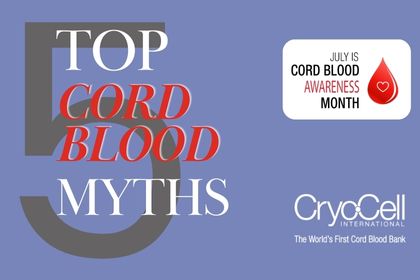
As the pioneering cord blood bank, Cryo-Cell has been at the forefront of the industry since its inception. Over the years, we have witnessed the emergence of various myths and misconceptions surrounding cord blood banking. In this blog post, we aim to dispel five common cord blood myths. Our goal is to empower you with accurate knowledge to make informed decisions for your family.
Myth 1: All cord blood banks are the same.
Contrary to the myth that all cord blood banks are equal, the reality is that not all banks adhere to the same stringent standards of quality and accreditations. We are proud to be the first cord blood bank, established in 1989, and our dedication to excellence remains unwavering. We stand out among other private cord blood banks due to our commitment to quality and innovation, as evidenced by our FACT (Foundation for the Accreditation of Cellular Therapy) and AABB (formerly known as American Association of Blood Banks) accreditations.
Our advanced collection kit also sets us apart from our competitors. It features vacuum-insulated panels and phase-change material gel packs that adapts to external temperature changes. This keeps the baby’s cord blood safe by maintaining the best temperature during shipping. To protect the viability of your baby’s stem cells, we also include an internal temperature indicator inside the box, which monitors the external temperature and alerts Cryo-Cell if optimal temperature wasn’t maintained during transport. Your nurse will appreciate the easy-to-use collection tray that houses the storage bag, cord tissue container and five vials to collect the mother’s blood. All of this comes in an easy-to-transport small suitcase-like box with a handle.
Once your newborn’s stem cells arrive at our lab, we will ready the stem cells for preservation. Our premium processing technology, PrepaCyte-CB, maximizes the potential therapeutic benefits of the stored cord blood unit by preserving a greater number of viable stem cells. Studies have shown that cord blood processed with PrepaCyte engraft up to 20% more quickly than any other processing method.
Myth 2: You can't do delayed cord clamping and save cord blood.
Delayed cord clamping can result in a smaller collection volume of cord blood; however, our PrepaCyte-CB is the only processing method on the market that is not affected by volume. It has been clinically proven to recover significantly more healthy progenitor stem cells than all other private banks' processing methods. So yes, you can delay and save when you bank with Cryo-Cell.
Myth 3: Private cord blood banking is too expensive.
Private cord blood banking is sometimes perceived as prohibitively expensive. Here at Cryo-Cell, we recognize the importance of making cord blood banking accessible to families. We offer various pricing options and flexible payment plans to accommodate different budgets as well as discounts for multiple births. What used to cost thousands, now averages around $650 for collection and less than $200 a year. We believe that the long-term health benefits and peace of mind associated with private cord blood banking outweigh the initial costs, making it a valuable investment in your child's future.
Myth 4: Cord blood cannot be used for siblings or other family members.
Thankfully, this is not true. As well as being an ideal genetic match for the donor, there is a 75% likelihood that these stem cells will be an acceptable match for siblings who share the same biological parents. To date, half of all stem cell transplants from us have gone toward siblings. Studies show that stem cell transplants between siblings have a higher success rate compared to unrelated donor transplants. A sibling match also decreases the risk of graft vs. host disease, a significant complication in transplants, to less than 10%. Also worth noting is that both parents have at least a 50% match to their child, which allows them to utilize the stem cells if needed. By privately banking cord blood, you create a safety net that extends to the whole family, offering potential medical options for future use.
Myth 5: The decision to privately bank cord blood can be made at the time of delivery.
While this one may be true for a small subset of hospitals that partnered with companies like Cryo-Cell to have cord blood banking collection kits available in the Labor and Delivery departments, most families will benefit from making the plans in advance. To ensure a smooth cord blood collection process, we recommend deciding no later than week 34. This allows us to send a collection kit directly to the expectant parents, so it can be packed in the hospital bag. It also gives time to inform and coordinate with healthcare providers beforehand so that they are aware of the plan and ready to collect the cord blood at the time of delivery. Again, not every hospital has collection kits on hand and if they do, it may not be a Cryo-Cell advanced 5-chamber collection kit.
We hope this post gave you more clarity about private cord blood banking. We are passionate about stem cell preservation for the protection of the family and making the process easy for our parents. We are here to answer all your questions.
Are you interested in learning more about cord blood banking? We’d love for you to join us for one of our upcoming virtual seminars!